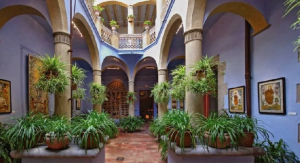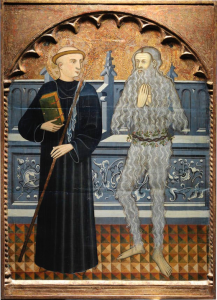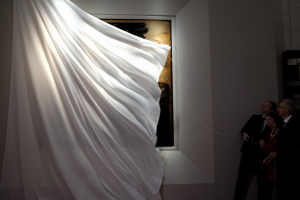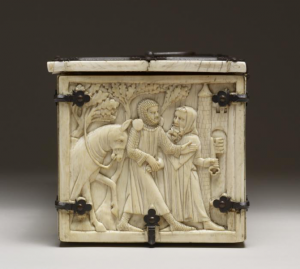1. Després d’un dia de platja.

La Fundació Mascort de Torroella de Montgrí mostra les Peces escollides de la col·lecció del seu fundador fins al 15 d’octubre. La idea era presentar-les com si fóssin la decoració domèstica habitual de la seu, la Casa Galibern, i ho han aconseguit. Hi podreu veure, entre altres, una esplèndida creu barcelonina del XV, atribuïda Pere Barnès. Pel gelat, Gelats Angelo (a la Bohème o El Cruixent).
2. Un català a Texas.

Appollo Magazine ens informa que el Meadows Museum ha comprat una taula amb Sant Benet i Sant Onofre atribuïda a Pere Vall. Datada c. 1410 és només la tercera obra d’abans de 1450. El feliç venedor és Sam Fogg, de Londres.
3. Ara que ja és públic.

José Ángel Montañés comenta a El País la llista d’obres adquirides per la Generaliltat durant el 2016 (“Más patrimonio para todos”, 1.05.2017). Inclou aquest Sant Jaume Apòstol del gironí Ramon Solà II, localitzat pel vostre segur servidor i destinat ara al Museu d’Art de Girona.
4. Espectacular.
El canvi de la gran Pietat Desplà de Bermejo després de la seva recent restauració (finançada per la Fundació Banc Sabadell) és simplement espectacular. Recomano molt la visita museu del claustre de la Catedral. D’altra banda, a l’octubre de 2018 el Prado inaugurarà una antològica molt completa de Bermejo (el comissari serà Joan Molina, explica la nota de la UDG).
5. El tresor de Ripoll.
Aquest és el vídeo que el Centre de Restauració de Béns Mobles de la Generalitat ha publicat sobre l’esplèndida restauració de la portalada de Sta. Maria de Ripoll – amb la col·laboració de l’empresa Arcovaleno. Aquí us podeu baixar un resum executiu de la intervenció.
6. Leonardo torna a brillar.

Als Uffizi ja hi torna a penjar l’Adoració dels Reis Mags de Leonardo, després de cinc anys i mig de restauració, precedits d’un any d’anàlisis diagnòstiques i reflexió (“Firenze, l’Adorazione dei Magi restaurata debutta ai Uffizzi”, La Reppublica, 27.03.2017). L’especialista Frank Zöllner la celebra com una brillant resolució de l’etern dilema de la restauració: retornar a l’estat original de l’obra o conservar les marques que hi ha deixat la seva història (“Ist Mückenschiss keine wahrhafte Geschichtsspur?”, F.A.Z., 26.04.2017).
7. Ivoris medievals, ara menys rars.

Buscant arquetes del XIV i el XV d’ivori, he descobert el Gothic Ivories Project mantingut pel Courtauld Institute: més de 5100 objectes en ivori de més de 400 museus i arxius. Impressionant.